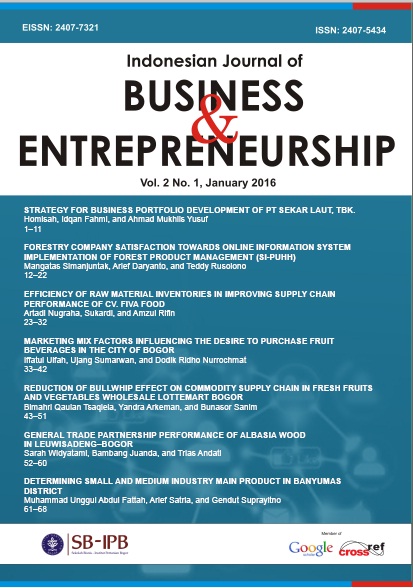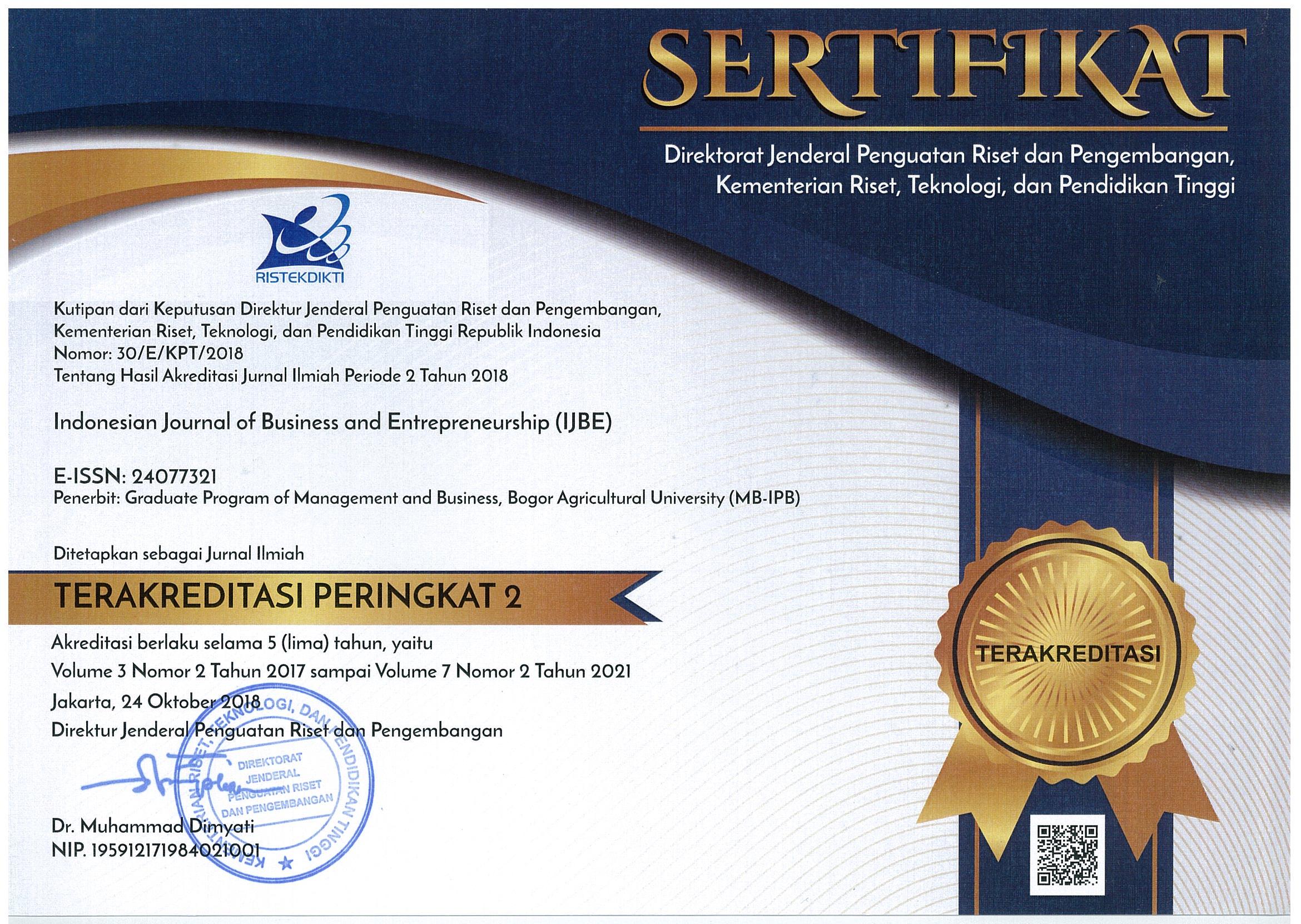FORESTRY COMPANY SATISFACTION TOWARDS ONLINE INFORMATION SYSTEM IMPLEMENTATION OF FOREST PRODUCT MANAGEMENT (SI-PUHH)
Abstract
This research was conducted with the aim 1) to analyze gaps that occurs between perception and expectations of the company implementation of SI-PUHH Online, 2) to analyze the level of satisfaction of the company implementation of SI-PUHH Online 3) Formulate a strategy to improve the quality of service implementation PUHH Information System Online. Analysis of the data used is the Importance Performance Analysis (IPA) and the Customer Satisfaction Index (CSI). The results showed that there are five attributes that considered important in determining customer satisfaction. These five attributes are: 1) System Online has a server that is up to date with internet bandwidth that is large so it is not easy down and can be accessed quickly; 2) response rapid administrator/operator; 3) accurate data in accordance with entrian company; 4) There is a backup server; and 5) Officer SI-Online PUHH always willing to help. The fifth attribute is an attribute that has a high level of importance, but in its implementation or performance is still unsatisfactory. Customer Satisfaction Index (CSI) on the implementation of this SIPUHH Online amounted to 72,07%, meaning that customers "satisfied" on the performance of services carried out by the Ministry of Environment and Forestry, but must maintain and improve the performance SERVQUAL PUHH Information System Online is to be able to satisfy the users company PUHH Information System Online.Keywords: SI-PUHH Online, SERVQUAL, IPA, CSI
Downloads
References
Al-Hudhaif SA. 2010. Measuring quality of Information System Services in manufacturing organizations in Riyadh. JKAU: Econ. & Adm 24(1): 151–171.http://dx.doi.org/10.4197/eco.24-1.4
Angelova B, Zekiri J. 2011. Measuring customer satisfaction with service quality using American Customer Satisfaction Model (ACSI Model). International Journal of Academic Research in Business and Social Sciences 1(3): 232–258.http://dx.doi.org/10.6007/ijarbss.v1i2.35
Eboli L, Mazzulla. 2009. A new Customer Satisfaction Index for evaluating transit service quality. Journal of Public Transportation 12(3): 21–39.http://dx.doi.org/10.5038/2375-0901.12.3.2
Ginting SP. 2014. Analisis kepuasan dan loyalitas pelanggan internet prabayar berbasi CDMA (Studi Konfirmasi Internet Service Provider CDMA di Tiga Mall di Bogor) [Tesis]. Bogor: Program Studi Magister Manajemen dan Bisnis, Sekolah Pasca Sarjana, Institut Pertanian Bogor.
Jairak K, Prasong P. 2013. Applying IT Balanced Scorecard and Importance Performance Analysis for providing IT governance strategy in university. Information Management & Computer Strategy 21:228–249.http://dx.doi.org/10.1108/imcs-08-2012-0036
James OM, Emmanuel OD, Robert A. 2012. Assessing farmers' satisfaction of agronomc services received in Ghana using the SERVQUAL Model, a Case Study of Kumasi Metropolis, International Journal of Business and Social Science 3:51–60.
Jiang JJ, Klein G, Parolia N, Li Y. 2012. An analysis of three SERVQUAL variations in measuring Information System Service quality. The Electronic Journal Information Systems Evaluation 15: 149–162.
Kang HM. et al. 2007. Importance-Performance Analysis of Forest Works for sustainable forest management in Korea. J.Fac. Agr., Kyushu University 41(1): 255–263.
Landrum H, Prybutok V, Zhang X, Peak D. 2009. Measuring IS System Service Quality with SERVQUAL: Users' perceptions of relative importance of the five SERVPERF dimentions. Informing Science: The International Journal of an Emerging Transdiscipline 12.
Levenburg NM, Magal SR. 2004. Applying Importance Performance Analysis to evaluate E-Business strategies among small firms. E-Service Journal 3:29–48. http://dx.doi.org/10.2979/ESJ.2004.3.3.29
Martilla JA, Jamaes JC. 1977. Importance-Performance Analysis. Journal of Marketing 41: 13–17.http://dx.doi.org/10.2307/1250495
Myerscough, Mark A. 2002. Information systems quality assesments: Replicating Kettinger an Lee's USISF/Servqual Combination. Eighth Americas Conference of Information System.
Romayah S. 2014. Evaluasi implementasi e-Government di Badan Koordinasi Penanaman Modal [Tesis]. Bogor: Program Studi Magister Manajemen dan Bisnis Sekolah Pasca Sarjana Institut Pertanian Bogor.
Rosidi. 2010. Analisis kepuasan konsumen terhadap kualitas pelayanan perusahaan (Studi Kasus di PT. Sang Hyang Seri Kantor Regional I Sukamandi) [Tesis]. Bogor: Program Studi Magister Manajemen dan Bisnis Sekolah Pasca Sarjana Institut Pertanian Bogor.
Simamora B. 2002. Paduan Riset Perilaku Konsumen. Jakarta:PT. Garamedia.
Tryan CK, Ross SC. 2006. Service quality expectations and perceptions: Use of the Servqual instrument for requirements analysis. Issues in Information Systems 7(1): 357–362.
Overdevest C, Rickenbach MG. 2006. Forest certification and institutional governance: an empirical study of the Forest Stewardship Council certificate holders In The United States, Forest Polucy an Economics 9: 93–102.http://dx.doi.org/10.1016/j.forpol.2005.03.014
Parasunaman A, Zeithaml VA, Berry LL. 1985. A conceptual model of Service Quality and its implications future research. Journal of Marketing 49 (Fall):44.
Wong MS, Hideki, George P. 2011. The Use of Importance-Performance Analysis (IPA) in evaluating Japan's e-government services. Journal of Theoretical and Applied Electronic Commerce Research 6: 17–30
Zeithmal VA, Parasunaman A, Berry LL. 1990. Deliver Quality Service: Balancing Customer Perception and Expectation. New York:The Free Prees.
Zuwita ER. 2012. Analisis kepuasan pengguna jasa pelayanan perizinan penanaman modal di Pelayanan Terpadu Satu Pintu (PTSP), Badan Koordinasi Penanaman Modal (BKPM) [Tesis]. Bogor: Program Studi Magister Manajemen dan Bisnis Sekolah Pasca Sarjana Institut Pertanian Bogor.








